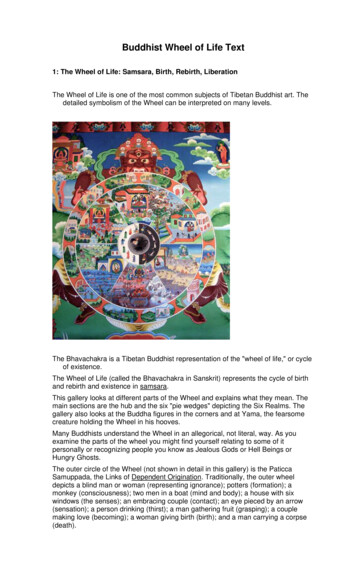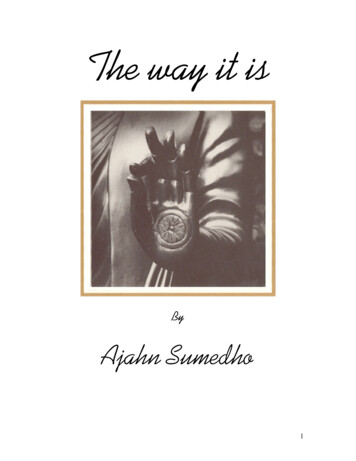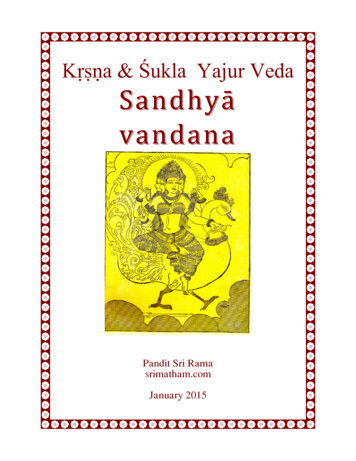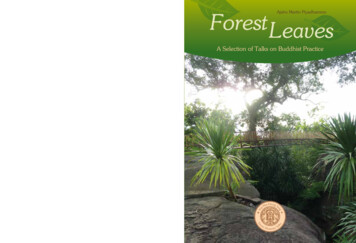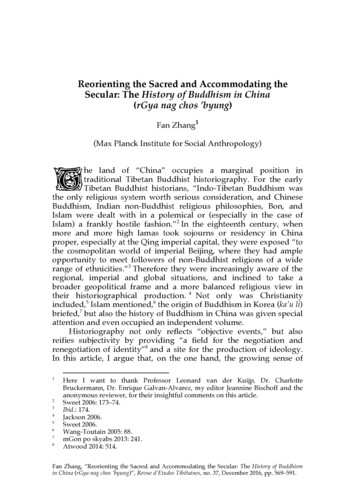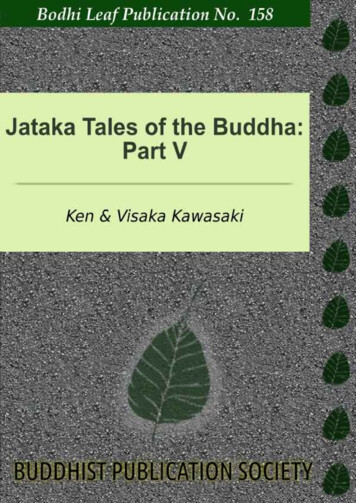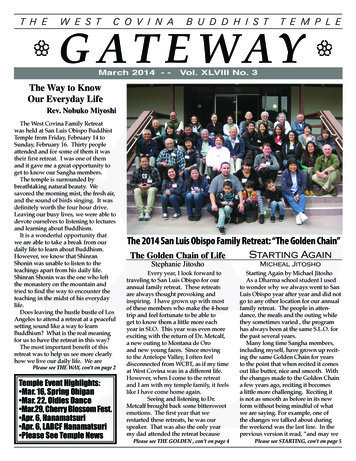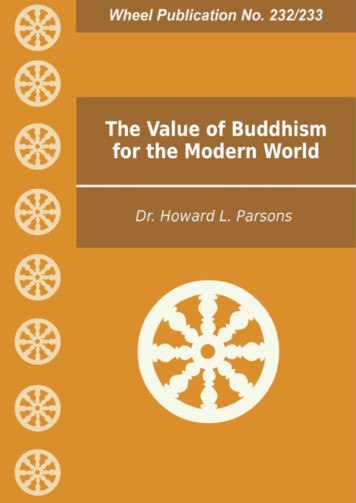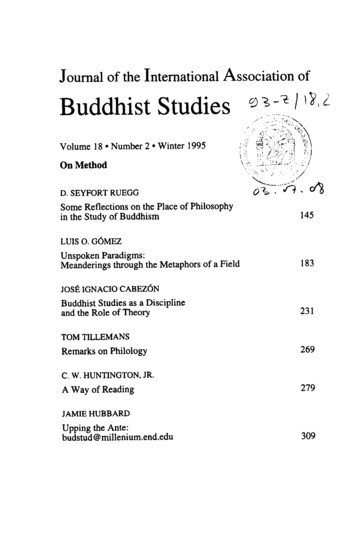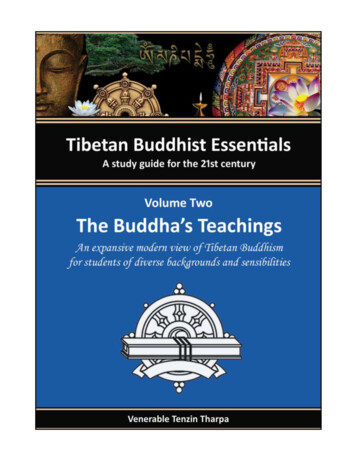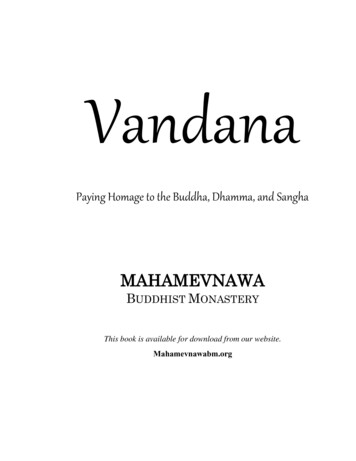
Transcription
VandanaPaying Homage to the Buddha, Dhamma, and SanghaMAHAMEVNAWABUDDHIST MONASTERYThis book is available for download from our website.Mahamevnawabm.org
2
ContentsContents . 3Vandana. 5Salutation to the Buddha . 5Going for Refuge . 5Observation of the Five Precepts . 6Buddhānuti Contemp tion on the Qu itie of the Buddh . 7Dh mmānuti Contemp tion on the Qu itie of the Dh mm . 7S nghānuti Contemp tion on the Qu itie of the S ngh . 8S tt Buddh V nd nā Hom ge to the Seven Buddh. 9Cetiya Vandana: Homage to Stupas and Bodhi Tree . 10Buddha Puja: Offering for the Supreme Buddha. . 11Invitation to the Deities . 13Namaskara: Salutation to the Buddha. 13K mmā Vā nā A king for Forgivene . 14Blessings chanted by the monks . 14Asking for Forgiveness and Sharing Merit with Bhantes. 15Loving Kindness Meditation . 16Glossary . 173
WelcomeWe hope that the explanations given throughout this book willmake your experience with us more meaningful. If you have anyquestions, don’t be afraid to ask.The special language we use in our devotional service is calledPali. It is the ancient language that the Buddha’s teachings arewritten in. By continuing to use this language along with atranslation we are able to keep a direct connection with theBuddha while at the same time understanding the meaning. Italso ensures that as modern languages change we can alwaysgo back to the original.The best way to learn Pāli pronunciation is by listening andchanting along. In brief, it’s helpful to know that in TH the H isalways silent, and that C and CH are both pronounced with ahard “ch.” The Ṁ is pronounced as “ng.” Lines over vowles—such as Ā, Ī, Ū—are held out twice as long as usual.One word we say throughout the service is “Sādhu!” It means“excellent.” You will also hear “Namo Buddhaya,” whichmeans “Homage to the Buddha.”In the time of the Buddha as well as today, people bow—as wedo—to show our respect and humility. We bow to show respectto the Buddha and his monastic followers. Even children areencouraged to bow to their own parents to show respect. Aswith all of the practices we do here, you are welcome to participate or observe in a way that feels comfortable to you.Be sure to browse our lending library to find more books tolearn the teachings of the Buddha.If you have any questions, please speak to one of the monks orvolunteers. Everyone wants to help you feel at home here.4
VandanaSalutation to the BuddhaThis is the same way that people expressed praise and honourto the Buddha even when he was alive.Sādhu! Sādhu! Sādhu!N mo tbh g v to r h toN mo tbh g v to r h toNamo tassa bh g v to r h dhassaHomage to the Blessed One, the Worthy One, the supremely Enlightened One!Homage to the Blessed One, the Worthy One, the supremely Enlightened One!Homage to the Blessed One, the Worthy One, the supremely Enlightened One!Going for RefugeThe primary way we express our commitment to follow theteachings of the Buddha is by going for refuge to the TripleGem: the fully enlightened Buddha; the Dhamma, his liberatingteachings; and the Sangha, the people in the past and the present who followed these teachings and also became enlightened.Buddhaṁ saranaṁ g hāmi.Dhammaṁ saranaṁ g hāmi.Saṅghaṁ saranaṁ g hāmi.Dutiy m’pi Buddh ṁ saranaṁ g hāmi.Dutiy m’pi Dh mm ṁ saranaṁ g hāmi.Dutiy m’pi S ṅghaṁ saranaṁ g hāmi.T tiy m’pi Buddh ṁ saranaṁ g hāmi.T tiy m’pi Dh mm ṁ saranaṁ g hāmi.T tiy m’pi S ṅghaṁ saranaṁ g hāmi.5
I go for refuge to the supreme Buddha.I go for refuge to the supreme Dhamma.I go for refuge to the supreme Saṅgha.For the second time I go for refuge to the supreme Buddha.For the second time I go for refuge to the supreme Dhamma.For the second time I go for refuge to the supreme Saṅgha.For the third time I go for refuge to the supreme Buddha.For the third time I go for refuge to the supreme Dhamma.For the third time I go for refuge to the supreme Saṅgha.Sādhu! Sādhu! Sādhu!The Buddha asked us to keep five training rules for as long aswe live. He taught that by following these precepts we canavoid many problems and build a firm foundation for developing our minds. We know that we can’t break the precepts byaccident, for example, when we step on an insect without knowing. If we do break a precept, we make the determination to tryto not do it again.LEADER: To observe the five precepts, say after me,1. I observe the precept of abstaining from killing beings.2. I observe the precept of abstaining from stealing.3. I observe the precept of abstaining from sexual misconduct.4. I observe the precept of abstaining from telling lies.5. I observe the precept of abstaining from taking intoxicating drinks anddrugs.I follow these precepts for happiness in this life for rebirth in heaven and to realize the Four Noble Truths in this Gautama Buddha’s Dispensation.Sādhu! Sādhu! Sādhu!6
Budd ā uCmQuBuddThe Buddha had nine special qualities. Buddhas are the onlyones who have all nine. We often recite them when we placeitems on the shrine.1. Iti pi o bh g vā, r h m,mmā-sam-buddho,3. vijjā-carana-sampanno,4. sugato, 5. ok vidū,6. anuttaro purisa-damma- ār thi,7. tthā dev -m nu ān m,8. buddho, 9. bh g vā ti.2.1. Such Indeed is the Blessed One, Arahant, worthy one,2. supremely enlightened,3. endowed with knowledge and virtue,4. follower of the Noble Path,5. knower of worlds,6. the peerless trainer of persons,7. teacher of gods and humans,8. the Enlightened Teacher,9. the Blessed One.D mmā uCmQuD mmAs well, the Buddha’s teaching, known as the Dhamma, has sixspecial qualities that make it possible to get the same happinessthat the Buddha did.1. Svākkhāto Bh g v tā dh mmo,2. sanditthiko, 3. kā iko,4. ehipassiko, 5. opanayiko,6. ptt m veditt bbo viūh ti.7
1. Well taught by the Blessed One is the Dhamma,2. visible here and now,3. timeless,4. open to all,5. learned and applied to oneself,6. understood by the wise each for himself.S g ā uCmQuS gThe group of people who followed the Buddha’s teaching to thegoal of enlightenment are known as the Sangha. In this groupare eight types of people: ones who have achieved the four different levels of enlightenment and ones who are on the wayguaranteed to achieve these four levels. The Buddha taught thatjust as seeds planted in a field without weeds will bring a greatharvest, in the same way gifts given to this group of people willbring great results.1. Su-paṭip nno Bh g v to āv k -sangho.2. Uju-paṭip nno Bh g v to āv k -sangho.3. Ñāy -paṭip nno Bh g v to āv k -sangho.4. Sām i-paṭip nno Bh g v to āv k -sangho.Y did m ttāri puri -yugāni aṭṭha purisa-pugg ā esa Bhagavatoāv k -sangho:5. āhu-neyyo 6. pāhu-neyyo7. dakkhi-neyyo 8. anjali-k r n yo9. anuttaram puññak-khettam ok ā ti.1. Of pure conduct is the Order of Disciples of the Blessed One,2. of upright conduct is the Order of Disciples of the Blessed One,3. of wise conduct is the Order of Disciples of the Blessed One,4. of generous conduct is the Order of Disciples of the Blessed One.Those four pairs of persons the eight kinds of individuals: that is the Order of Disciples of the Blessed One.8
5. They are worthy of offerings,6. they are worthy of hospitality,7. they are worthy of gifts,8. they are worthy of reverential salutations,9. an incomparable field of merit for the world.Satta BuddV d ā H mgSBuddOnly one Buddha ever exists in the world at a time. After histeachings disappear from the world, sometimes eons pass bywithout another Buddha attaining enlightenment. From ourBuddha named Sidhartha Gautama, we learn that there haveonly been seven Buddhas in the last 91 eons. They all discovered the very same Dhamma and taught it to disciples who alsoattained enlightenment. The verses below are found in theĀṭā ā y Sutta, from the Long Discourses of the Buddha.1. Vipassissa namatthu, cakkhu-m ntir m to.Sikhissapi namatthu, sabba-bhū-tā-nukampino.2. Vebhu n m tthu, n hā-takassa tapassino.Namatthu Kakusandhassa, Mār - enā-pamaddino.3. Koṇāg m nn m tthu, brāhm ṇvu m to.Kassapassa namatthu, vip-pamut-tassa sabbadhi.4. Aṅg rn m tthu, ky -puttir m to.Yo imaṁ dhamma-ṁadesesi, sabba-dukkhā-p nūd n ṁ.5. Ye āpi nibbutā oke, y thā-bhūt ṁ vipassisuṁ.Te j nā pi uṇā, m h ntā v t ār dā.6. Hitaṁ deva-m nu ān ṁ, yaṁ namassanti GotamaṁVijjā-caraṇa-sampannaṁ, mahantaṁ v t ār d ṁ.Vijjā-caraṇa-sampannaṁ, Buddhaṁ v ndām Got m ṅ’ti.9
1. Homage to Vipassi the Buddha possessed of the eye of wisdom andsplendor. Homage to Sikhi the Buddha compassionate towards all beings.2. Homage to Vessabhu the Buddha free from all defilements and possessed of great energy. Homage to Kakusanda the Buddha the conqueror of the army of Māra.3. Homage to Konagamana the Buddha who has shed all defilements and has lived the holy life. Homage to Kassapa the Buddha who is fully freedfrom all defilements.4. Homage to Aṅgirasa the Buddha Gotama son of the Sākyas full of radiance who proclaimed the Dhamma that dispels all suffering.5. Those in the world who have extinguished the flames of passion and haverealized through insight things as they really are they never slander anyone they are mighty men who are free from fear.6. Gotama the Buddha dear to gods and humans endowed with knowledgeand virtue mighty and fearless we pay homage to our Great teacher Supreme Buddha.Cetiya Vandana: Homage to Stupas and Bodhi TreeThere are several physical objects we use as a focus for our devotion to our teacher, the Buddha. One is the parts of his body,such as bones and hair, that remained after he died. These areoften placed in burial mounds called cetias or stupas. Anotheris the tree he sat under when he attained enlightenment. Thethird is statues and paintings of the Buddha.V ndāmi cetiyaṁ sabbaṁ—Sabba-ṭhāne u p tiṭṭhitaṁSār r k -dhātu-M hā-bodhiṁ—Buddha-rūp ṁ sakalaṁYmū e ni inno v —S bbāri vij y ṁ kā,Patto sabbaññutaṁ S tthā—Vande taṁ Bodhi-pād p ṁ.10dā.
Ime ete M hā-Bodhi—Loka-nāthen pūjitā,Aham-pi te n m āmi—Bodhi-Rājā n m’ tthu te!I show my humble reverence to all the stupas in all of the places that they stand the bodily relics the Great Bodhi Tree and all the Buddha images forever.I show my reverence to this Bodhi-tree seated under which the Teacher attained full Enlightenment by overcoming all defilements.I, too, honor this great Bodhi-tree which was honoured by the Leader of the World My homage to thee O king of Bodhi-treesSādhu! Sādhu! Sādhu!Buddha Puja: Offering for the Supreme Buddha.One way we show our gratitude to our teacher the Buddha is bymaking offerings. Of course the Buddha is no longer alive anddoes not actually receive these gifts. By remembering his special qualities as we make the offerings we develop a strongersense of who he is and what he was able to do. As our faith inthe enlightenment of the Buddha grows, these actions becomemore meaningful.In the Vimanavatthu 4.9, we learn, “If people offer something tothe Supreme Buddha when he is alive or after he has passedaway, as long as they have the same confident mind on both occasions, the results will be the same. Beings are reborn inheaven because of their confident minds.”11
My great teacher Supreme Buddha eradicated passion hatred and delusion. My great teacher Supreme Buddha Eradicated the desire of seeing forms.Eradicated the desire of hearing sounds.Eradicated the desire of smelling odors.Eradicated the desire of tasting flavors.Eradicated the desire of touching tangibles.Eradicated the desire of thinking thoughts.Supreme Buddha controlled sense faculties guarded sense faculties restrained sense faculties.Supreme Buddha is free from defilements.My great teacher Supreme Buddha purified his body speech and mind.In this way my great teacher Supreme Buddha is an Arahant.Supreme Buddha understood suffering as a Noble Truth. eradicated the origin of suffering as a Noble truth. attained the cessation of suffering as a Noble Truth. followed the Path leading to the cessation of suffering as a Noble Truth.In this way Supreme Buddha realized the Four Noble Truths without anyone’s help escaped from suffering and achieved true happiness.I offer with great respect these beautiful flowers sweet fragrance sweet drinks and bright light to my great teacher Supreme Buddha.Sādhu! Sādhu! Sādhu!12
Invitation to the DeitiesAs we know, the Buddha taught not only humans the path tofreedom from suffering but also gods and divine beings. As fellow disciples, we invite them to come and listen to the Buddha’steachings being recited.S m ntā kk -vā e u–Atrā-g h ntu dev tāSad-dhammaṁ muni-rāj–Sunantu sagga-mokkha-daṁParittas savanna-kā o y ṁ bh d ntāParittas savana-kā o y ṁ bh d ntāParitta Dhammas-savana- kā o y m bh d ntāTranslation:In the universe in their entirety, let the deities come here;The good doctrine of the King of SagesThat gives heaven and release.This is the time to listen to the protective discourses.This is the time to listen to the protective discourses.This is the time to listen to the protective Dhamma discourses.Namaskara: Salutation to the BuddhaThis is the same hommage that we recited at the beginning.N mo tN mo tN mo tbh g v to r h tobh g v to r h tobh g v to r h dhassaNext we recite a scripture from the brown MahamevnawaPali-English Paritta Chanting Book. Most of the passages inthat book are sermons preached by the Buddha.After that we will do loving-kindness meditation. This will be aguided meditation, so you can listen silently, cultivating thewholesome wish that all being would be free from suffering.13
Kammā Vāā Ak ggThe Buddha taught that we benefit from recognizing our faultsand abandoning them. Although the Triple Gem cannot actuallyforgive us, developing a wish to overcome our shortcomingscan lead to our happiness and well-being.Kāyen vā ā itten , p māden m yā k t ṁAccayaṁ kh m me bh nte, Bhūri-pt thāg tKāyen vā ā itten , p māden m yā k t ṁAccayaṁ kh m me dh mm , S nditthik kā ik .Kāyen vā ā itten , p māden m yā k t ṁAccayaṁ khama me saṅgha, puññak-kettaṁ anuttara.Translation:If, due to negligence, I have done some wrong, by body, speech, or mind,Forgive me of that offense, O Bhante, perfect One of vast wisdom.If, due to negligence, I have done some wrong, by body, speech, or mind,Forgive me of that offense, O Dhamma, visible and unaffected by time.If, due to negligence, I have done some wrong, by body, speech, or mind,Forgive me of that offense, O Sangha, supreme field of merit.Blessings chanted by the monksAbhivād n - i —Niccaṁ vuḍḍhāp āyino;C ttāro dh mmā v ḍḍhanti—Āyu v ṇṇo sukhaṁ balaṁ.Āyurā rogyto nibbānmp tti—sagga sampatti mevacamp tti—imina te samijjhatuTranslation:For the person who worships virtuous peopleAnd always reveres and serves the elders,Four things increase: long life, beauty, happiness, and power.May you have long life and be free from illness.May you have rebirth in heaven.May you one day attain Nibbāna!14
Asking for Forgiveness and Sharing Merit with BhantesAt the end of the devotional service we ask forgivenessfrom and share merit with senior monks. We will do the samething after the Dhamma talk.Okāsa vandāmi Bhante. (bow once)Mayākataṁ puññaṁ, sāminā anumodi tabbaṁ.Please, Bhante, kindly allow me to share with you the merit I have collected.(Bh nte Sādhu, Sādhu, numodāmi!)Good, good, I rejoice!Saminā katam puññaṁ, mayhaṁ dātabbaṁPlease Bhante, kindly share with me the merit you have collected.(Bh nte Sādhu, Sādhu, numodeth !)Good, good, I share!Sādhu, Sādhu anumodāmi!Good, good, I appreciate!Okāsa! Dvārattena kataṁ sabbaṁ accayaṁ khamatha me BhanteForgive me, oh Bhante, of any offences I may have committed by body, speech, or mind.(Bh nte K māmi k mit bb ṁ)I forgiveOkāsa khamāmi Bhante!(bow)I ask for forgiveness, oh Bhante!Dutiyam’pi okāsa khamāmi Bhante!For a second time, I ask forgiveness, oh Bhante!Tatiyam’pi okāsa khamāmi Bhante!For a third time, I ask forgiveness, oh Bhante!15
Loving Kindness Meditation(1) May I be free from anger.May I be free from ill will.May I be free from jealousy.May I be free from mental suffering.May I be free from physical suffering.May I live in peace. May I livehappily.(5) May all beings in this country. be free from anger. be free from ill will. be free from jealousy. be free from mental suffering. be free from physical suffering.May they live in peace.May they live happily.(2) May all beings in this monastery. be free from anger. be free from ill will. be free from jealousy. be free from mental suffering. be free from physical suffering.May they live in peace.May they live happily.(6) May all beings in this world. be free from anger. be free from ill will. be free from jealousy. be free from mental suffering. be free from physical suffering.May they live in peace.May they live happily.(3) May all beings in this city. be free from anger. be free from ill will. be free from jealousy. be free from mental suffering. be free from physical suffering.May they live in peace.May they live happily.(7) May all beings. be free from anger. be free from ill will. be free from jealousy. be free from mental suffering. be free from physical suffering.May they live in peace.May they live happily.live happily. live happily.(4) May all beings in this province. be free from anger. be free from ill will. be free from jealousy. be free from mental suffering. be free from physical suffering.May they live in peace.May they live happily.16
Glossarybhante: a respectful way of addressing a monkbhikkhu: monk. Female version: bhikkhunideva: can refer to all heavenly beings in general or specifically the lower classof heavenly beings, the other being brahmas. (Not to be confused withbrahmins, the priestly caste in India.)kamma: (Sanskrit: karma) intentional actions we do that have good or badresults based on the type of action.lay people: followers of the Buddha who live ordinary lives while practicingthe teachings, as opposed to ordained monks and nuns.M h mevn w (m h MAY oo NA w ) “G rden of the Gre t C oud.” Thi ithe name of the most ancient monastery in Sri Lanka and also the name of ourorganization. In tropical countries clouds are often the only relief from theburning sun.Mār A non-human being who tries to prevent people from practicing theDhammamerit: all kinds of good actions that lead to good results.Namo Buddhaya: “Homage to the Buddha.”Pā i the n ient ngu ge of the Buddh ’ te hing .saddhā: (Sanskrit: shraddha) faith, confidence.sādhu: excellent, very good.saṁsāra: the cycle of death and rebirth that only comes to an end with fullenlightenment.sutta: (Sanskrit: sutra) the scriptures taught by the Buddha and hisenlightened disciples who lived when he did.Theravād “Te hing of the E der ,” the o de t tr dition of Buddhi m,common in Sri Lanka, Thailand, Burma, and Laos.17
Pali. It is the ancient language that the Buddha’s teachings are . written in. By continuing to use this language along with a translation we are able to keep a direct connection with the Buddha while at the same time understanding the meaning. It also ensures that as moder
